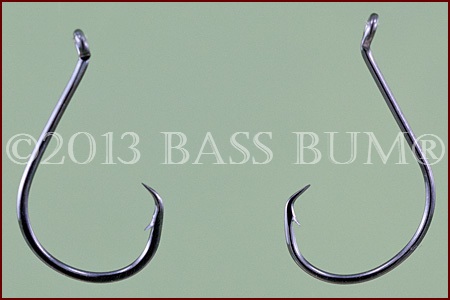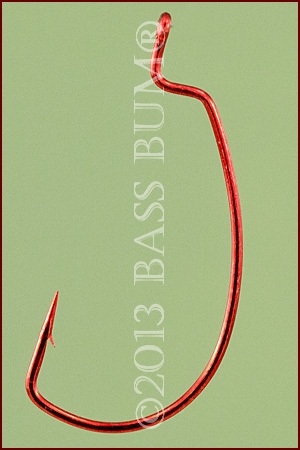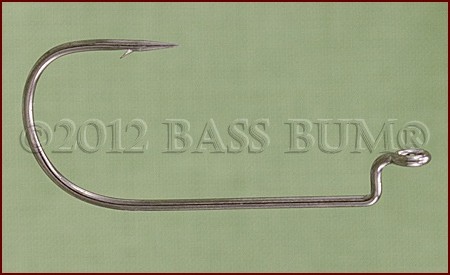Use Circle Hooks "Correctly"
You Might Catch More And Injure Fewer Bass

"Circle hooks? I just don't think that hook can catch fish."
If you have ever seen these hooks you have very likely said something to this effect. I know I did. That is until I caught my personal best smallmouth, over five pounds, on one of these hooks and a shiner the first time I used them.
Now I must point out that I hooked the bruiser by "accidentally" fishing the hook "correctly". I was paying little attention at the time and when I lifted my rod and began to slowly reel in my line to recast, all the while talking to my fishing partner about politics or something, I actually thought I as hung. Then, my line began to move rapidly toward deep water and the fight was on.
When I landed her the hook was indeed right in the corner of the mouth where I understood the hook should be. The smallmouth was completely unharmed and released to fight another day.

- So what exactly is a circle hook?
- Why should you consider using them?
- How do you fish them so you can catch bass on them?
These fish hooks have been around for many years used primarily by commercial "longline" fishermen. These guys needed a hook that could be relied upon to hook a fish "passively", that is, without a hook setting action. When "longlining" there is not constant attention given the rig(s) so it is important that hooks used "assist" the fish in hooking themselves. A circle hook does just that. These hooks have transitioned to freshwater bass fishing due to the growing importance of "catch and release" as a part of bass conservation, not to mention the very strong desire for these hooks among fly fishermen.
What are the hooking mechanics of circle hooks?
The fundamental design of a circle hook is one where the point of the hook literally points inward toward the shank of the hook.
These hooks are designed this way so that when a fish (in our case, a bass) takes the bait and begins to swim away the line will tighten and as it does begin to pull the hook through its mouth till the eye of the hook is outside the mouth. At this point, the hook twists (the shank is pulled towards the back of the fish) and the hook catches (sets itself) in the corner of the mouth.
Does this really happen? Well, yes and no. Sometimes it does, sometimes it doesn't. It all depends on whether you "DON"T SET THE HOOK PROPERLY" or not. That's right, I said, don't set the hook.
The correct way to hook a fish with one of these hooks is to, when you feel the fish, merely lift your rod tip to take up slack and begin to steadily reel. If you try to set the hook with a snap set you will only pull the hook out of its mouth and good bye bass. Be aware also that if the bass is swimming toward the boat there will be less chance of it becoming hooked until it turns or passes under the boat.
Some "authorities" say you should let the bass run with the bait before tightening your line. I've done this and the problem with doing it is that the bass will often swallow the hook, which is not good of course. So, if you use them pay close attention to your line and hesitate only briefly before tightening you line and reeling. Do this and you and the bass will be rewarded for your efforts.
Why do I say you and the bass will be rewarded for your efforts?
You will be rewarded because studies have shown that fish hooked with circle hooks tend to "stay hooked". It is difficult for a fish to throw a circle hook as one look at the inward directed point clearly shows. You may actually hook up more times with a traditional J-hook but you'll stay hooked up more with circle hooks.
 |
 |
As for the bass, the same studies show that fish suffered lower rates of mortality when caught on circle style hooks. They also avoided injuries such as liver, gill and intestine damage that results from swallowing a traditional J-hook type (like those shown in comparison at above) because, while it can happen as I pointed out, if fished properly the incidence of swallowing is low. Furthermore, bleeding related to where a fish is hooked was also reduced since most times the hook was in the jaw. Having said this, one place these hooks do have the potential of causing damage is to the eye. They sometimes will penetrate the eye orbit when setting.
Generally, however, the benefits of circle hooks are:
- easier hook removal
- fewer hooks swallowed resulting in less internal injuries
- lower fish mortality (great for catch and release)
- easier to set the hook (when done properly)
- fish that stay hooked after hook set
- fewer hooks in the anglers fingers due to the hook design

A Note On Tackle For Fishing Circle Hooks
These hooks work better with fish that inhale their food, like bass. Fish that nibble what they eat are not good candidates since the hook must be in the mouth for it to work.
It follows then, that since an angler is not snatch setting the hook in the usual manner but merely reeling in, heavy action rods are not best. Rods that are softer and give the bass a chance to pull against the rod without letting loose of the bait while it is coming through the mouth to the corner are better.
Another point to consider is hook size. If the hook is to large it will not do a sufficient job hooking small fish. Correspondingly, if too small, it will miss large fish or be more likely to be swallowed. Unfortunately, there is a lack of any standardization as to circle hook sizing from manufacturers.
When fishing live bait for largemouth and smallmouth bass, I use Gamakatsu Octopus Circle and Eagle Claw circle style hooks in sizes 2, 1, 1/0 and 2/0. There are many other good brands on the market. The size 1 and 1/0 are the sizes I use most.
What about circle style hooks with artificial plastics?
I've had success using them by nose hooking soft plastics including worms, stick baits like the Senko and small grubs. You fish them the same as you would the live bait...don't set the hook!
Should you use circle fish hooks? If you're a subscriber to "catch and release" as a means of conserving our wonderful smallmouth and largemouth bass and you're a live bait fisherman you should give them a try, no question.
Return To Fish Hooks From Circle Hooks
